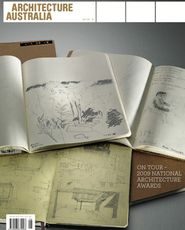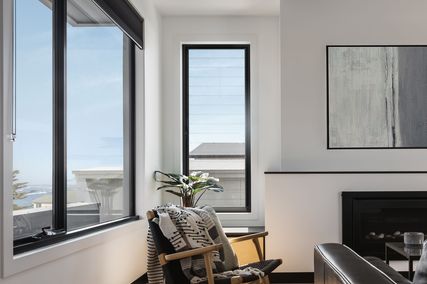The outcomes of a hectic fourteen days surveying recent Australian architecture.
The jury spent a hectic fourteen days surveying recent Australian architecture. We sincerely thank all those who met us and ensured open doors at all the properties. We had a relatively seamless tour across the country, including excursions to Port Arthur, Bendigo and the Snowy Mountains. The jury came together from far and wide and, considering how little we knew of each other, we proved to be a cohesive group with clear consensus at the end.
In evaluating buildings for the 25 Year Award we came away with a real appreciation of the period circa 1960 – a time of great enterprise and endeavour in Australia, and with a quantity of very fine buildings resulting. Commodity, firmness and …. delight. We saw some beautiful fifty-year-old architecture that continues to be used and enjoyed and is attractive, engaging and fun.
By way of contrast, some of Australia’s recent “high architecture” takes itself very seriously. It can be rectilinear, somewhat rigid, lacking colour and movement. The jury was somewhat surprised that almost classical approaches to planning, language and structure remained dominant in the face of emergent computer/digital-facilitated technologies. Where are the New-Age buildings which are clearly available to the twenty-first century?
Contemporary architecture can be user-friendly and engaging. Probably that’s what so appealed to the jury about the Sydney project Ivy, with its embodied ideal that commerce and a darned good time can come together in a pleasure palace of meeting, greeting, eating and imbibing. Here one gets a sense of a special precinct integrated into the heart of Sydney. A typical visitor can appreciate and enjoy many aspects of Ivy and recognize it for what it is: a well-resolved and consciously designed entity.
A number of the entries clearly showed the importance of the individual client/patron, in particular their ability to be more adventurous and to gain a more significant result. So often in Australia, smaller, inventive and highly competent architectural practices are excluded from larger commissions because they lack the experience of four or five equivalent projects. The informed client/patron is often the only chance to crash through this barrier into larger work. The Pindari and Cottesloe apartments, the Sussan Sportsgirl headquarters and Ivy reveal how much can be achieved through a shared vision held by both the client and their architect.
Urban design is paradoxically stronger in the commercial buildings – where the benefits of diverse, social spaces and permeable spacial layouts are now de rigueur – than in the defined category. This suggests little current gutsy investment in urban design infrastructure and the public realm. It would also be timely for Australian landscaping, through better plantsmanship, to consider some more imaginative choices: moving beyond endless Manchurian pear trees in the forecourt, and within, acres of mother-in-law’s tongue.
It was felt that in due course all award-winning projects will have to state their sustainable credentials. The projects this year showed a wide range of initiatives: sunshading and screening, on-site power generation, more considered air supply systems, water storage and used-water treatment plants. The jury’s interest in sustainability included the importance of buildings being built to last, with minimum maintenance and easy adaptive reuse, and the need for a Green Star sustainable rating system that appropriately evaluates substantial existing buildings.
Given that 50 percent of architects’ work in the future will be the adaption of existing buildings, the jury noted that alterations and additions to important heritage buildings deserve more than the application of standard heritage maxims, which might avert a disaster but are unlikely to achieve a truly memorable and worthy result. This requires a skilled designer who can appreciate and enhance the best qualities of the original.
Among the projects submitted, one observed the difference in consistency between the residential category and most other categories. In terms of generous budgets, construction quality, integration with site and landscaping, and specificity to brief and client – all these were givens in the residential work, but less so in most other categories (the award winners notwithstanding). Is Australia’s architectural reputation forever reliant on the one-off house?
The exemplary quality of execution, complexity of the design task or project scale are no substitute for poetry of intent, or clarity in expressing the great idea. Australia needs to move on from the “bigger is better” syndrome, and indeed the awards need a place to recognize those socially worthy projects which are an important facet of contemporary practice.
A number of the architects we met spoke of the difficulty in getting their ideas accepted and approved – for outstanding buildings – which brings into question the assessment of architecture through the planning and approval process by people without significant design training or knowledge of building construction.
Many such issues deserve national initiatives and coordination. Australia’s government has a responsibility to provide leadership, and this must include better strategic planning and consistent approval procedures, and a built environment which is clearly improving. Nearly every state and territory has recognized the need for the appointment of a government architect to guide policy and decision-making in this area; however, the Commonwealth continues to have no such advisor. A Commonwealth government architect, given sufficient influence, could guide all government built environment initiatives towards better outcomes. Imagine all the government schools assisted under the present stimulus package achieving buildings of award-winning quality – and a lasting legacy.
Howard Tanner, 2009 Australian Institute of Architects National Jury chair.
JURY
Howard Tanner (chair), Richard Harris, Peter Poulet, Rachel Hurst, Peter Malatt















